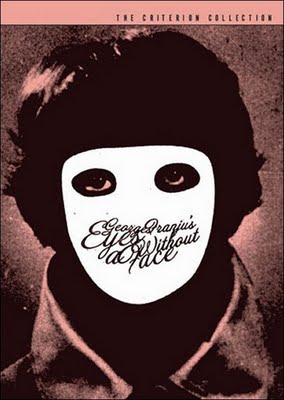Eyes without a face (Georges Franju, 1962): France / Italy
Reviewed by Pamela Carvalho. Viewed at the AFI Fest 2011.

One of the themes of Eyes Without a Face is about the issue of human identity. Christiana complains of looking in the mirror or seeing her reflection in a window or a spoon and not recognizing herself, whether it’s when she is wearing the wax mask or the face that once belonged to another girl. She sees someone who looks a bit like her but not herself. Each persons visage is a big part of her identity, but Christiana has been reduced to a mannequin. Christiana wonders whether it is worth living at all if she can’t live as her own self. She begins to long increasingly for release from her suffering, through death. The film title is doubly apt because it describes both the victims of Dr. Genessier’s surgical procedure who have had their faces stolen, as well as Christiana in her mask, with her eyes the only visible element that is truly her.
Another less obvious issue of the film is the tyranny of patriarchy. Dr. Genessier dominates the woman in his life, both Louise and Christiana, not to mention the young women whom he treats as mere sources of tissue. His objectification of the victims is worse than the objectification of women as sex objects; here, they are reduced to mere tissue donors. Emile, Edna and Paulette were forcibly abducted and unlawfully confined, but Christiana is also a caged bird in a way, as unable to leave her father’s abode as the others. The doctor uses stray dogs cruelly for his medical research, but Christiana is also being used for his experiments, even if as a recipient rather than a donor.
A third theme relates to our sometimes spurious claims to be doing something out of love. Dr. Genessier undoubtedly believes that his motivation for his grotesque activities is love for his daughter, but he is really only acting to assuage his own sense of guilt. The doctor’s professions of love and, in one scene, affectionate interactions with a little boy further highlight by contrast the horror of his cruel abuse of the young women. It if infinitely more frightening to observe a creature of horror that is very human at times than one that is fully perverse.
The cinematography of the film though, is magnificent. The use of light and shadows were used very creatively which was highly effective. The soundtrack is pretty nifty as well.
The highlight performance definitely belongs to Edith Scob (Christana). Reduced to acting only with her eyes and her physicality, I really think she manages a highly stylized performance that reveals an amazing range of emotions, from longing, to resignation, to anger, to pain. Her darting eyes are magnificently large and expressive, and reveal a fevered agitation and distress about her condition.
Though Eyes Without a Face was contemporaneous with the first films of the French new wave, you feel that it takes it’s own course. I generally dislike horror films but have a deep appreciation, usually, for art films, so I was determined to find out how I would react to an artsy horror film. There was one disgusting scene in the film that I could just as well have done without, though it is probably the only one scene that true fans of horror films will find up to their standards. I very much enjoyed the atmospheric parts, the cinematography, the character portrayals, all the artsy aspects of the film, but not the horror per se. That’s just me. If you like the classics of horror, such as “Psycho” and “The Exorcist”, you’re bound to enjoy this film. If you prefer straight blood and guts, you might be disappointed.
About this entry
You’re currently reading “Eyes without a face (Georges Franju, 1962): France / Italy,” an entry on Student Film Reviews
- Published:
- 11.11.11 / 5pm
- Category:
- AFI Filmfest 2011, Films
1 Comment
Jump to comment form | comments rss [?] | trackback uri [?]